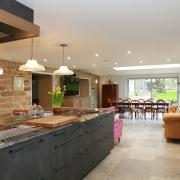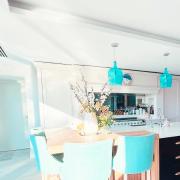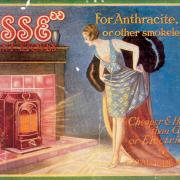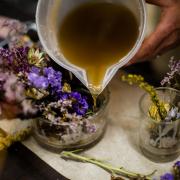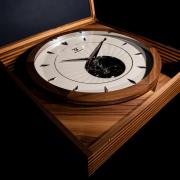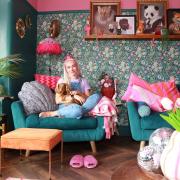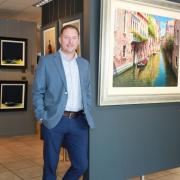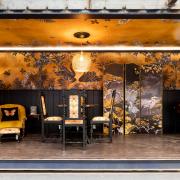Sir Peter Moores, Lancashire's most remarkable philanthropist, is selling his home of half a century for �9.5 million. Emma Mayoh reports
Sir Peter Moores is a man who has touched the lives of millions. The son of Sir John Moores, the founder of the Littlewoods football pools empire, he used the family fortune to help others and he is reputed to have given away an astonishing �93 million. His own foundation has been devoted to helping people in many walks of life, but particularly young people, and the arts.
Now, Sir Peter is saying farewell to Lancashire and he is selling his stunning home, Parbold Hall, near Wigan, for �9.5 million, making it almost certainly the most expensive property on the market in Lancashire. We were lucky enough to be invited inside the grand front doors of this stunning house for a tour, courtesy of Sir Peter.
He was just 25 when he bought what has been described as one of the most historic houses in the North West. He’d spent the previous three years pursuing his first love, music, studying at the Vienna Academy of Music and Dramatic Arts as well as working as a volunteer production assistant with the Vienna State Opera.
He wanted to pursue a passion for opera – a fire ignited as a small boy when he rifled through the cupboards and discovered his father’s record collection. But it was not to be.
In 1957, he returned to Lancashire to work for the family firm and bought Parbold Hall a year later. ‘I got a letter from my father saying that he had better sell my part of the shares if I wasn’t going to be around so I moved back. I was aware of the hall before I moved back but I lived with my family at first.’
Sir Peter read about Parbold Hall in a book by Peter Fleetwood-Hesketh. ‘It said the hall was empty and in need of care. I thought “I’ll go and have a look at that”. When I did see it I thought I could deal with it. It was quite a mess, but a solid, strong mess.
‘You could stand in many of the rooms and see the birds flying above you. It had been empty for a long time. The previous residents had moved out of one end of the house in about 1940. In the other end they kept chickens in rooms that had floors. There weren’t many of them though because there weren’t that many floors left.’
It took Sir Peter two years to restore the hall. The design of the gutters, which unusually were designed to drain into the centre of the roof, created a dry rot problem, which also meant much of the original plasterwork had to be replaced.
Sir Peter changed the drainage as well as making other structural changes. This included altering the aspect of the house from north facing to south facing to make the most of beautiful views over the Douglas Valley. He raised the entrance hall ceiling to make it double height and made alterations to the room layouts.
There were also improvements to the garden. A stunning water feature was built in front of the house and a swimming pool, no longer in use, was installed. Sir Peter also planted more than 170 acres of woodland, partly to shield the noise from the nearby M6 and to hide the view of industrial Wigan. It also sheltered the hall from strong winds.
The earliest parts of the current hall are in the east side of the building and were built in the 17th century. But there are traces of an earlier building and there would have once been a farmhouse on the site. There was also another hall, built by the Lathom family, which would once have existed close by.
The main part of the current building dates to the 1740s when it was owned by Thomas Crisp MP. He added to the house and made alterations. He may have used Italian architect, Giacomo Leoni, who was then working extensively in Lancashire on country homes, including Lathom Hall. After Thomas left, with no male heir, it was tenanted by English Benedictine monks expelled at the time of the French Revolution.
Today, Parbold Hall is a remarkable Lancashire house with nine bedrooms and eight bathrooms. Over the years, Sir Peter has extended the estate from just over 200 acres to more than 800. Some of the land is used for shoots which regularly yield more than 200 pheasants in a day.
The house is also brimming with an impressive art collection that he has built up from auction houses such as Sotheby’s and Christies, complementing the Compton Verney gallery he created n Warwickshire. These include work by some of his favourite artists including Italian Pietro Fabris, who did grand tour paintings that sir Peter describes as ‘expensive postcards’.
He said: ‘I have very much enjoyed buying art for this house because I can buy the things I love. When I buy for Compton Verney I can’t be that frivolous because I have to consider the collection that’s already there. With the hall I can just choose those things that I really love.’
Sir Peter is now planning to move to London to be closer to the things he enjoys doing. This means selling some of his collection. One gilt-bronze and cloisonn� enamel tiger water pot recently sold at Sotheby’s for �825,000. But despite spending more than half a century building up his life and his collection at Parbold Hall, he is not sad to be leaving.
‘I have had happy times here but I am not one to think about how much I will miss it. I’m going to be 80 soon and I don’t want to be living in a big house like this by myself.
‘I won’t miss Lancashire because I will make sure I am back here regularly to visit my friends. I won’t tell the next owners what to do with the hall either. I might give them a few pointers but the next phase of Parbold Hall will be down to them.’
A knight to remember
Sir Peter was never the sort of philanthropist who handed over the money and ran. ‘Most people aren’t as nutty as I am,’ he once said.
‘Most people just want to give you the money and go away. I’m not like that.’He was born in Lancashire and educated at Eton College and Christ Church, Oxford, where he studied Italian and German. As a student he worked at Glyndebourne before going to Vienna.
In 1957 he joined his father’s business, Littlewoods, becoming vice-chairman in 1976, chairman from 1977 to 1980 and remaining a director until 1993. He has been a Governor of the BBC, Trustee of the Tate Gallery and a Director of Scottish Opera. He is also a member of the British Museum Society. He received the Gold Medal of the Italian Republic in 1974, an Honorary MA from Christ Church, Oxford, in 1975, and was made an Honorary Fellow of the Royal Northern College of Music in 1985.
In 1992 he was appointed a Deputy Lieutenant and he was appointed a Commander of the British Empire (CBE) in 1991. In the 2003 New Year’s Honours List he received a Knighthood.
He says his his life-long aim has been to create opportunities for others, especially young people. He is also patron and founder of the respected Compton Verney Art Gallery, a Robert Adam mansion he restored in the Midlands and turned into an artistic treasure trove.



